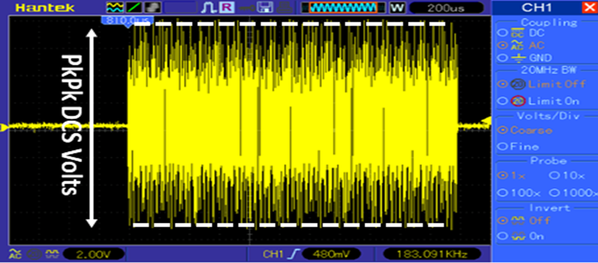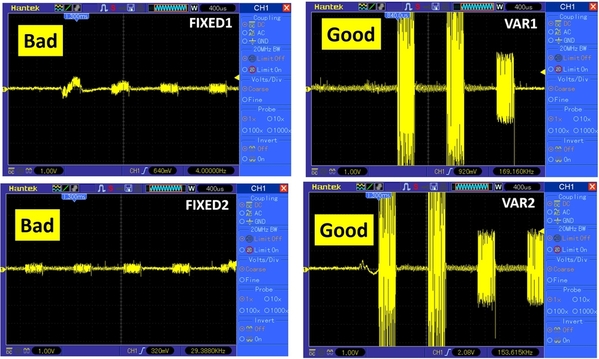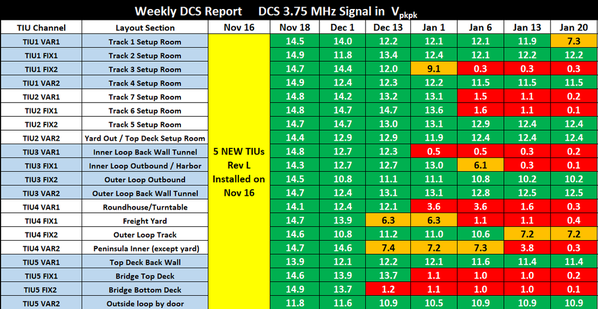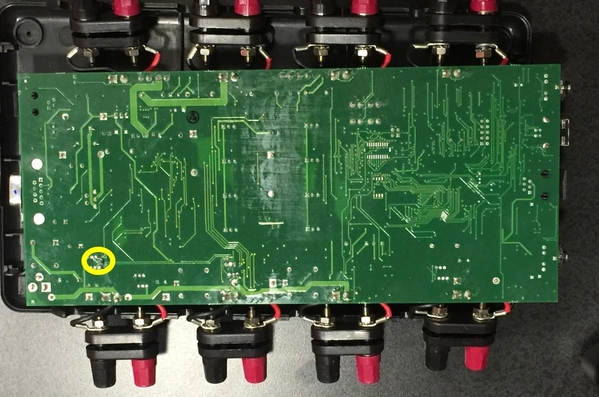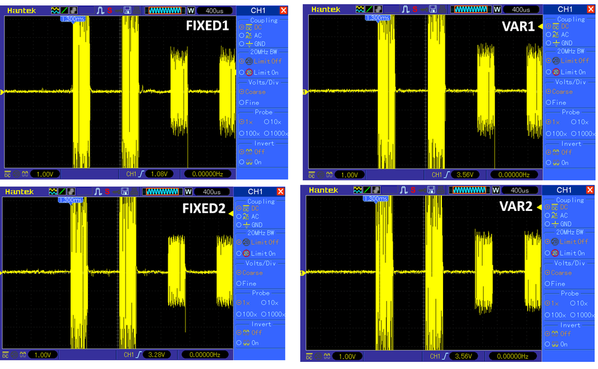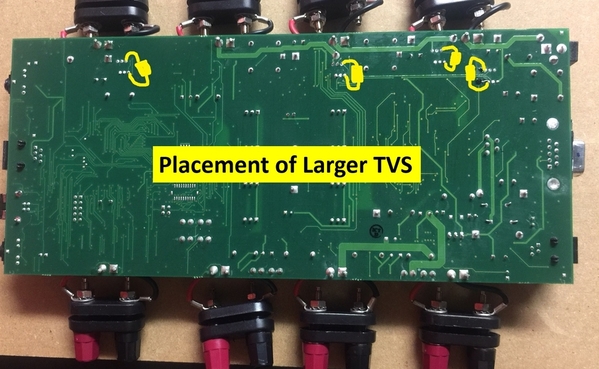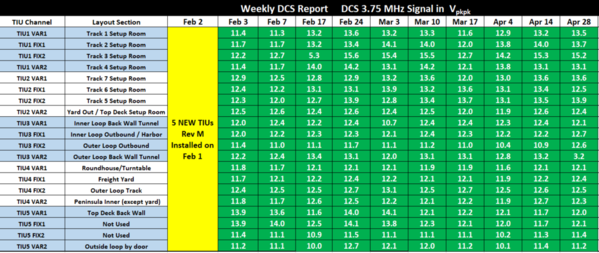Okay...
So a few of the very intense (stan2004, gunrunnerjohn, GGG, Barry of course) DCS intense folks might remember the struggles my club was having with weak DCS signals. Specifically that after a few weeks the excursion voltage of the digital/CDMA signal on the track would fall from like 15V new out of the box, to like 0.1V. We had long discussions here on the forum did lots of measurements, swapped lots of parts but never really nailed it down.
Well although I've been pretty quiet, we've actually got the whole story worked out now from problem to solution. Before the details... I have to say Jason W and engineering at MTH helped me quite a bit on figuring this thing out.
======== QUICK RECAP ========
Right so let me do a quick recap so everyone knows how this went down. At our club I go around with an oscilloscope every week and measure the DCS voltage levels on each of the 4 outputs on each of our 5 TIUs. (Only the cool kids bring an oscillscope to a train club?) This is not track power, this is the digital DCS signal. If you need to brush up on DCS signals you can look at the (old post) and (old post2).
The measurement I do is to send some DCS packets out of each TIU output without it connected to the layout, and measure the DCS pk-to-pk excursion voltage like this:
So typically out of the box new the DCS signal pk-pk excursion is about 15V. As we ran our layout we found some sections started to have poor control, then eventually no control. Investigating the DCS signals showed that the channels driving these sections suffered very low output DCS voltage (even when the TIU channel wasn't even connected to the layout). For example here is a TIU pulled out of the layout and measured on the bench with 2 bad channels:
So at first we didn't really understand this too well. We weren't sure how long our layout was like this, and if the TIUs were defective from day 1 or not. On Nov 16 2017 we replaced all 5 TIUs in our club with brand new out of the Box "Rev L" TIUs. From that day on, each week I would measure each TIU channel 1 by 1 (Disconnected from the layout) and write down the excursion number.
Here is our actual log sheet:
As you can see from the measurements taken, we only lasted about 2-3 weeks before the DCS levels started dropping on the brand new modules. When we setup the 5 new TIUs on Nov 16 we also installed those PSX-AC units recommended to us by gunrunnerjohn and put the entire layout in passive mode. So that was 5 TIUs and 20 PSX-ACs (A substantial investment!).
After this disaster we decided we would reverse engineer the TIU to try and figure out the root cause of failure. There was a lot of swapping of SMD parts between good and bad channels but nothing really came of it until I talked to Jason W at MTH...
======== ROOT FAILURE ========
So the reason we didn't catch the failure with all the swapping is becasue the failing part is well hidden and not actually on the PCB. Somewhere between the TIU rev where they laid out the PCB and the rev L that's sold today someone at MTH engineering decided to add teeny tiny SMD TSVs to protect the ACT244s, but there's no pads for them on the PCB, they are cleverly added to existing components.
Actually all of these tiny TSVs are hidden from plain sight. Var 1 is hidden under the output transformer, Fixed 1 is hidden under a heat-sink, Fixed 2 is on the back, and Var 2 is conspicuously soldered in parallel with another resistor.
So the moment you un-solder these TSVs the signal excursion goes back to normal (although now your ACT244s aren't protected and if something happens you'll be replacing those instead).
All good again:
I pulled the part number off these TSVs and replaced them, and yeah things worked for a few days (Jan 21,22,23), but then it failed again back to 0.1V (sad). So clearly it was just not a big enough TSV to handle either the peak currents or peak voltages that happen during train mishaps. Actually for some reason, running a lot of Lion Chief trains seems to really fail these diodes faster than MTH or other Lionel trains (maybe something about the motor inductance and peak inverse voltage.... who knows?).
======== THE FIX PART 1 ========
So the first thing we did is try to replace those sad SMD tiny TSVs with bigger ones. The MTH guys showed me other points on the PCB where we could "get at" the same nodes as the original TSV devices. Here is map of that. Sorry I didn't take a photo with the TSVS on when I had it open, and I don't want to open up a working one just to take a photo.... You guys are smart. I'm sure you get the point.
So the TSVs we ended up using are these ones (TSV device). So the idea was just solder them on there in those spots and you should be good to go. Note that TSVs come in 1 of two varieties (one diode and two diode). If you get the one diode one you only have unipolar protection so you need to solder two back to back to get bipolar suppression (yes it matters a lot actually).
We ran the layout like this for a little bit (Jan 24-29) and it mostly worked but we still had the odd failure (like 1-2 channels total). By destroying a few TSVs on the bench I found they don't like to sit in the clamped condition for too long or their clamp voltage starts to drop. With the PSX-ACs in there, that shouldn't happen, but I guess it did.
======== OUR CURRENT SOLUTION rev "M?" ========
So the thing about TSVs is they are zener based devices... so they are very fast but they don't like to continuously dissipate power. On the other hand basic rectifier diodes are not very fast switching devices, but they are happy to dissipate power (think rectifier bridge in a power supply) as long as you need. So the obvious design answer was to have two parallel clamps, a fast acting one, and a slower, but beefy one. It just so happens the 9.2V clamp voltage on the TSV is close to an integer multiple of the typical 1n4148 diodes used to support EE100 lab classes across the country.
So what we did is build a little daughter board for each channel with two strings of parallel series diodes (up and down) that clamp at roughly 9.1V (about 0.7V X 13). We ran wire to the backside of the board and glued the daughter boards on top of the relays (they do fit, but barely). Since this is the "slow" clamp the wire inductance won't hurt you on the time constant. As I mentioned, we use a basic 1n4148 diode.
It looks like this when everything is in:
======== RESULTS ========
I'm not 100% sure why the larger TVS devices are over-stressed but the parallel clamp seems to be working fine so far. While my friends bring trains to run, I bring my oscilloscope and probes to our club and just disconnect and measure each channel one-by-one week after week.
Since updating to this revision "M?" configuration on Feb 2 here are the measurements completed:
I've said it's solved 3 times now and been proven wrong, so at this point I'll just say, we've measured the DCS voltages weekly for almost 3 months, and seen no issues, so the evidence is leaning that way. I will continue to measure into the future, and will post if we do see a failure. So far so good though!
======== FINAL THOUGHTS ========
The SMD TSVs are so weak, and they fail to like 1-2 ohms across the ACT244 output. Even just a momentary short and you can loose 99% of your signal swing pretty much instantly. Since we put these new revisions in, you really don't get engine "not-on-track" or failure to add engines anymore. Track signals seem solid no matter how horrendous the actual wiring is. I'm sure this failure is a cause of grief for a lot of people besides just us. Of course if you don't have an oscillscope it's hard to tell.
Anyways, the smart MTH guys have all the details, the measurements, and even the PCB layout of my little daughter board, so I guess it's up to them how to proceed with it.
So yeah, if the TIU-train communications are lousy, check the hidden tiny TSVs.




